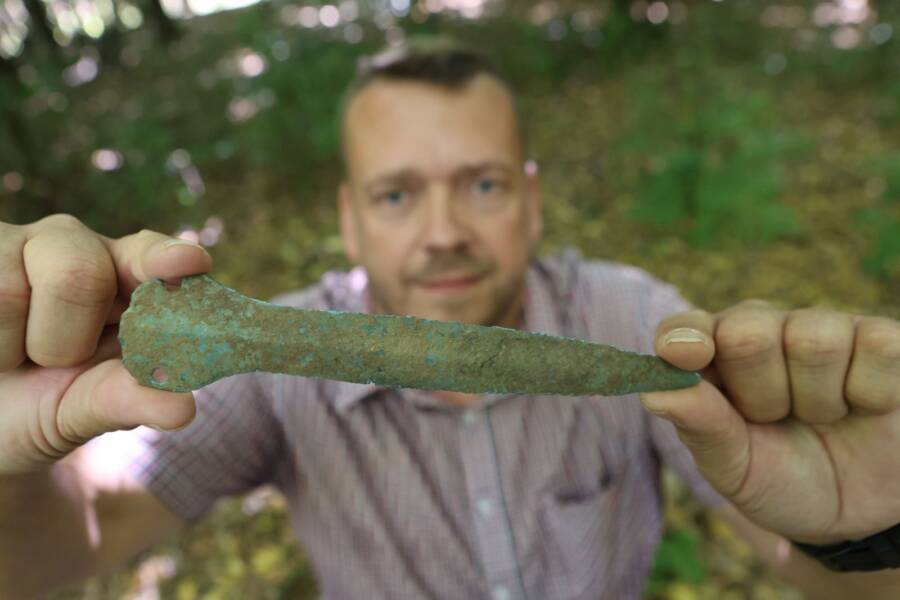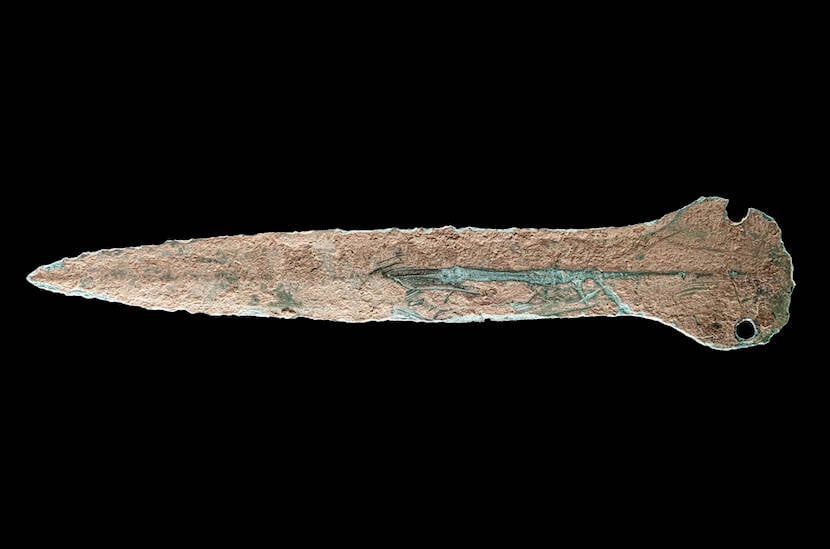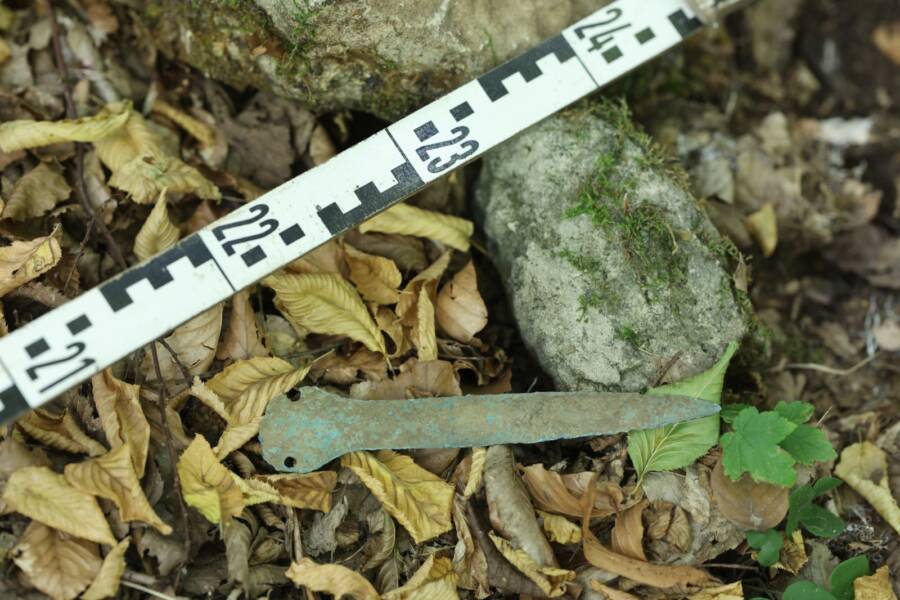While strolling through the forest near Gudersleben, Maik Böhner suddenly noticed that "something greenish flashed from the forest floor" — and realized he'd stumbled upon a Bronze Age blade.

Matthias Bein/dpaMaik Böhner holding the dagger that he found in Gudersleben. Archaeologists noted that it’s rare to find a dagger from the Bronze Age that’s this well preserved.
A German man was recently out for a walk in the woods with his two young sons when he stumbled upon an ancient dagger lying on the ground.
Found near the village of Gudersleben in Thuringia, the dagger is approximately 3,500 years old, dating back to the Bronze Age.
According to experts, a discovery like this is extremely rare, especially because the artifact was uncovered almost completely intact. Now, the dagger will be preserved and studied before being put on display, allowing archaeologists to learn more about the daily lives of those who lived in central Germany more than three millennia ago.
How Maik Böhner Found An Ancient Dagger Lying In Plain Sight On A Forest Floor
Maik Böhner found the dagger by chance while out for a walk with his two sons, according to the German news outlet Bild. It was simply lying face-up on the forest floor.
Experts believe the dagger ended up in this unique position thanks to heavy rains washing away the soil, leaving this ancient artifact exposed. It’s actually not uncommon for heavy rainfall to reveal archaeological artifacts in this region of Germany.
The area is prone to sinkholes and soil movement, and it’s home to many underground streams. These geological features allow for artifacts buried in the ground to be revealed in the wake of storms or heavy rain.

Hauke Arnold/Thuringian State Office for Monument Preservation and ArchaeologyMeasuring eight inches long and made of bronze, the dagger was found astonishingly intact.
The type of blade that Böhner stumbled upon is known as a plate-tanged dagger, a variety with a domed and riveted hilt that’s specific to the Bronze Age. The dagger is nearly eight inches long and features a wide and flat blade.
Just after finding the dagger, Böhner reported it to the Thuringian State Office for Monument Preservation and Archaeology in Weimar. Archaeologists applauded Böhner for taking appropriate action by immediately reporting the find, rather than trying to hold onto the dagger himself.
“I am very pleased that everything was reported correctly,” said Daniel Scherf, an archaeologist with the State Office.
According to Scherf, a find like this is very exciting and uncommon. The dagger is incredibly well preserved, making the find all the more exceptional.
“Objects like this are not everyday discoveries. To see a Bronze Age dagger so well preserved is something truly special,” Scherf explained.
The History Behind The Bronze Age Dagger Found In The Forest Near Gudersleben
Daggers such as this one served as tools more so than weapons. Owning one was a way to signify status and power. They were also used in ritualistic contexts in early European societies.
To make a dagger like this one required skill in not only crafting the blade, but also forming the handle, which was usually made out of wood, bone, or antler. Impeccable craftsmanship was required for the dagger to survive repeated use in various ceremonies or perhaps even in battle.

Matthias Bein/dpaThe dagger is nearly eight inches long and is made of bronze.
Because bronze was such a prized resource, the dagger was likely a valued possession. While archaeologists don’t know who owned the dagger, it’s likely it was someone of high status, such as a warrior or a leader. It’s also possible that the dagger was ultimately left where it was as a funerary offering.
The dagger dates back to somewhere in the middle of the Bronze Age, between 1800 and 1400 B.C.E. Archaeologists will be able to determine a more exact age once they begin further analysis of the artifact.
Furthermore, this rare discovery has provided archaeologists with the opportunity to take a look at the everyday lives of people who inhabited Thuringia thousands of years ago. But for Böhner, the find provides a much simpler revelation.
“In two years, we’ll be celebrating 1,100 years of Gudersleben,” Böhner said. “This find proves that people lived here much earlier.”
For now, the dagger is being cleaned and preserved, before being further examined at the State Office in Weimar. Eventually, the rare dagger will be put on display at the local history museum in Ellrich.
After reading about the discovery of this rare Bronze Age dagger, take a look at the rare dagger found in a Polish forest. Then, learn about the 4,500 year-old flint blade found in Germany.





